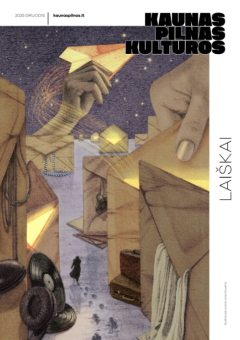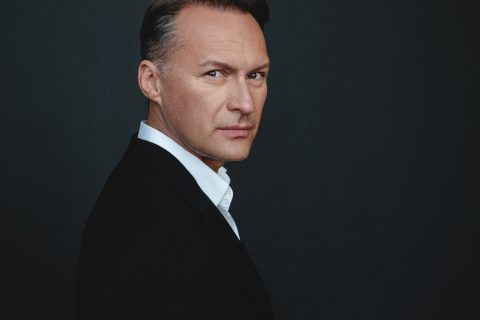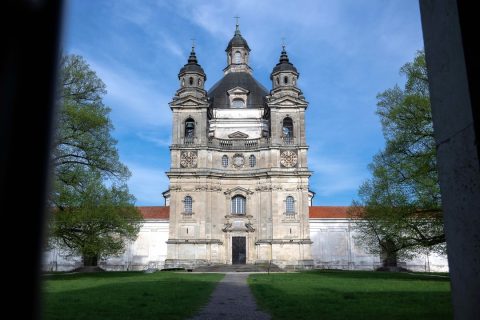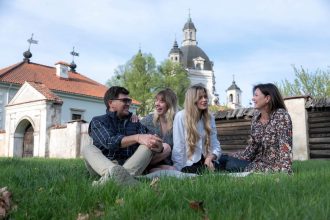The thirtieth anniversary of the Pažaislis Music Festival is not only a reason to enjoy the spectacular concerts but also an opportunity to look at what often remains unseen: work in the cafés, managerial challenges, and human dramas. Giedrė Mikaitienė, who became the festival’s director nine years ago and was previously known as the head of the Communications History Museum, tells us all about it. It was also interesting to hear her own career story as an experienced strategist.
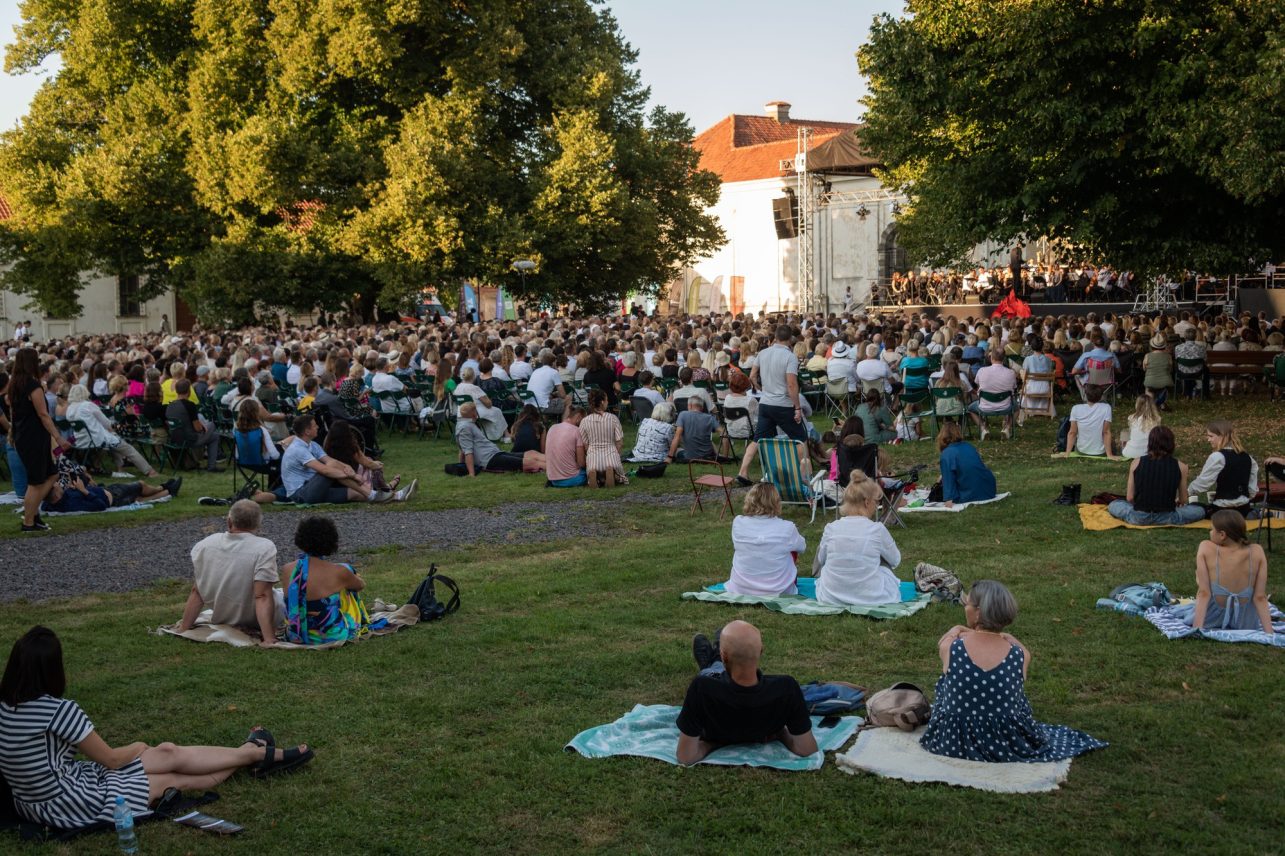
It all started from nothing
Although we can no longer imagine summers without concerts in manors, churches, and old town courtyards, three decades ago classical music simply wasn’t performed outdoors in Lithuania during the warm season. “The Philharmonic season ended in May, and then everyone went on vacation,” Giedrė Mikaitienė recalls. At the time, such concerts were held only in Palanga – which attracted crowds from all over Lithuania as it still does today – the Tiškevičius Palace Park. The Night Serenades tradition was started by Saulius Sondeckis and the Lithuanian Chamber Orchestra in 1970 and Giedrė attended them with her mother.
Europe was inspiring, Domarkas had no faith
When Lithuania opened up to the world, and the world to it, good examples, such as classical music concerts in European castles and monasteries, did not take long to inspire. The idea came from the late Petras Bingelis, head of the Kaunas State Choir, and Justinas Krėpšta, the current head of the Kaunas State Philharmonic (who is also Giedrė Mikaitienė’s brother-in-law). The unique location that set the tone for three decades of the festival’s history was suggested by Juozas Gudzinevičius, who was in charge of the Philharmonic’s facilities. As a restorer, he had worked in the monastery that had been returned to the Sisters of St. Casimir after the Soviet occupation.
However, as G. Mikaitienė recalls, the initial reaction to holding a concert here was skeptical. “Juozas Domarkas said, ‘What are you guys thinking, bringing a symphony orchestra to these meadows?’ In a word, he was very skeptical about the idea.”
The tradition began with Messiah
Despite skepticism, the first concert took place in 1995 with George Frideric Handel’s 18th-century oratorio Messiah. This work, incidentally, will also open the 30th Festival. “On a plywood stage, without a roof… There were so many people that there was not enough room on the benches, they all flooded as if it was a church festival,” the current festival director, who attended the concert as a spectator, recalls.
Three missions
From the very beginning, the festival which invited everyone to its first “true” summer in 1996, consistently maintained three directions: to be democratic (which means that the suit is not mandatory, and one can come in jeans), to revive neglected heritage sites, and to uphold the highest artistic standards, even if that means making unpopular decisions, “In other words, no kitsch, whatever the genre.”
A timeless audience
“Classical music is like an onion – you peel it back and discover new layers. After all, jazz, fado, flamenco, and finally even rock have already become classic. That’s why every year we have at least a few concerts of a different genre, but always of the highest quality. This is also how we expand our audience. While classical music tends to attract older audiences around the world, it’s great to see that our festival has a growing young audience, as surveys show. Colleagues are surprised and ask how we manage to attract them,” G. Mikaitienė opens up. More about what young people and children discover at the festival is written by my colleague Agnė Sadauskaitė in another article of this issue.
Focus on heritage
The Pažaislis Monastery, restored by the long-time festival director’s own hands, helped define one of the festival’s key directions. Today, it’s easy to forget that the Kaunas Castle tower – now home to a branch of the Kaunas City Museum – was abandoned just a few decades ago, despite its location in the heart of the city. “Homeless people really did live in the castle, and we were the first to enter St. George’s Church after the pharmaceutical warehouse that had operated there during Soviet times was cleared out,” G. Mikaitienė recalls. For example, in the old church of St. John the Baptist in Zapyškis water used to drip onto the piano. And that went on for several years, “Everyone would pray for good weather not just in Pažaislis, but in Zapyškis too.”
Running with the wolves
The current generation of music lovers will certainly not remember, but once upon a time, the Pažaislis Music Festival used to organize theatre performances in Kaunas Castle. They were dedicated to Statehood Day and were often followed by curious accidents. “Back then, the castle served more like a backdrop. I think it was in 2004 when Vytautas Grigolis staged a tragedy based on Maironis. In it, Vytautas the Great rides in with horses, and Grigolis decides that to enhance the hunting atmosphere, wolves are needed, so they bring them in from the zoo. But then the horses get spooked…” G. Mikaitienė recalls those times when she was still just an observer.
Later, the Pažaislis Music Festival moved to other heritage sites, and another event – Operetta at the Kaunas Castle – organized by a different collective, took root next to Kaunas Castle. “And we continue our mission, almost every year discovering an abandoned gem that could use a revival. And sure enough, when you hear music in such a space, you realize that the festival is also a social phenomenon,” the Kaunas resident reflects.
From sports club to classical music
As I have already mentioned, my interviewee has been managing the festival for nine years, and all this time she has not had her own office – she meets the pianist who coordinates the program, J. Krėpšta’s daughter, Lina Krėpštaitė, to work in cafés, and communicates with the festival’s artistic director Edgaras Montvidas remotely. “There’s also an accountant and two festival friends who help with communication,” the director introduces the small kitchen. In the past, she has been involved in several ambitious business management projects, including managing sports clubs, hotels in Kaunas and Palanga, and even working in a TV tower in Vilnius. Eventually, through previous contacts with the then Lithuanian Telecom, she made her way to the Communications History Museum. If you haven’t been there, you’ve probably heard of Ryšių kiemelis 837 (Communications courtyard), a legendary summer venue (partly replaced by OLDMAN Kaunas), and this legend came about not without Giedrė’s blessing. And how did she fare when she began working with musicians, performers, and creators? Were they willing to be led?
“I actually experienced quite a shock because I found myself in a completely different culture, I even started smoking, because otherwise I just couldn’t communicate with the artists about things like budgets. I remember you’d step outside, and within ten minutes, everything would be agreed upon,” G. Mikaitienė laughs. She was invited to join the festival by her brother-in-law, who one day casually said, “How long are you going to keep going back and forth from Palanga to Vilnius?” And so, she replaced J. Gudzinevičius, who was preparing to retire. Incidentally, Laura Gudzinevičiūtė, the daughter of one of the founders of the festival, is now in charge of the Pažaislis Festival communication with her colleague.
On competition
Although there are few direct competitors, the festival and its director maintain the position that high-quality art should be paid for. “People don’t value what they get for free, even if it’s top-tier art. That’s why professional culture should be paid for, even symbolically – this way, it attracts a genuinely interested audience.” When the conversation turns to festivals in other parts of Lithuania – especially in the capital – which were born out of love for classical music and are now opening up to other genres, G. Mikaitienė assures that the festival has no plans to organize concerts in Vilnius.
A concert center on the horizon
The major concerts of the festival take place, of course, at the Pažaislis Monastery. Other stops include churches and manors. This year, a concert will also be held on Owl Hill. The Kaunas State Philharmonic is also a very important festival venue. However, every time you visit it, it seems that the building could do with a bit of a facelift. What would though serve in its place? Like many promoters of classical music, the eyes and ears of the festival are on the upcoming M. K. Čiurlionis Concert Centre. On the left bank of the Nemunas River, on a plot of more than 4 hectares in Žemoji Freda, the center, designed by the studio of National Prize winner Rolandas Palekas, will cover an area of 14,000 square meters. However, we do not yet know the opening date of the center and, according to G. Mikaitienė, it will not happen before 2029, so her team is not yet planning any specific events there, although they already have some ideas for 2028. “I believe that the city will spare no investment in acoustic systems. As for the audience… It will all depend on the operators of the concert center and the pricing,” she reflects.
